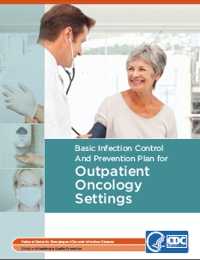Information for Health Care Providers

Each year, about 650,000 cancer patients receive chemotherapy in an outpatient oncology clinic in the United States. Patients receiving chemotherapy are at risk for developing infections that may lead to hospitalization, disruptions in chemotherapy schedules, and even death. Neutropenia is recognized as the most serious hematologic toxicity during cancer treatment with chemotherapy.
Ongoing outbreaks and patient notifications in outpatient settings demonstrate the need for greater understanding and implementation of basic infection prevention guidance.
Outpatient oncology facilities can use the Basic Infection Control and Prevention Plan for Outpatient Oncology Settings to standardize and improve infection prevention practices. It includes key policies and procedures outlined in CDC’s Guide to Infection Prevention in Outpatient Settings: Minimum Expectations for Safe Care that have been tailored to help outpatient oncology facilities meet minimum expectations for patient safety.
Program Materials
CDC produced materials to help promote awareness about the importance of preventing infections in cancer patients. The fact sheet is intended to be handed out to patients and caregivers. The posters can be placed in patient waiting areas, staff lounges, emergency rooms, and anywhere that patients and health care providers might view them.
Posters
- Emergency Room Personnel poster [PDF-401KB]
High-resolution version for professional printing [PDF-9MB] - Cancer Is a Fight. Don’t Let the Flu Knock You Down poster [PDF-1.5MB]
- Out of Sight, Out of Mind poster [PDF-185KB]
High-resolution version for professional printing [PDF-181KB]
Other Materials
- Cancer, Infection, and Sepsis fact sheet [PDF-576KB]
- Injection Safety Reminders for Oncology Providers [PDF-741KB]
- Neutropenia and Risk for Infection: What You Need to Know fact sheet [PDF-174KB]
High-resolution version for professional printing [PDF-173KB] - Cancer Is a Fight. Don’t Let the Flu Knock You Down postcard [PDF-3.5MB]
- Prevent Infections During Chemotherapy podcast [2:52]
- 3 Steps Toward Preventing Infections During Cancer Treatment Web site
More Information
- Cost of cancer-related neutropenia or fever hospitalizations
- Infection prevention in outpatient oncology settings: CDC offers tools to fight back against infections among cancer patients [PDF-682KB]
- CDC Medscape Commentary: New Tool to Prevent Infections During Chemotherapy by Dr. Lisa Richardson
- CDC Medscape Commentary: Protect Outpatient Oncology Patients from Infections by Dr. Alice Guh
- Health Care-Associated Infections
- Safe Health Care Blog
- Hand Hygiene in Health Care Settings
- Healthcare Infection Control Practices Advisory Committee (HICPAC)
- Infection Control in Health Care Facilities
- Infection Control Clinical Trials
- Health Care-Associated Infections (HHS)
- Save Lives: Clean Your Hands campaign
- Page last reviewed: February 24, 2014
- Page last updated: April 26, 2017
- Content source:
- Maintained By:



 ShareCompartir
ShareCompartir